Posted by Jefferson Bryant3 Comments on How To Use Sea Foam Motor Treatment: 3 Ways To A Cleaner Fuel System Know How
Over time, the internals of your engine can get clogged up with all kinds of nasty stuff. Inside the crankcase, where the oil lives, varnish and tar build up on the surfaces of the pistons, rings, lifters, and in the oil galleys that supply the oil to all the components. Oil can’t flow as easily to where it needs to go. This reduces the engine’s ability to cool and lubricate itself, reducing the efficiency, performance, and life of the engine.
The same build up occurs inside the fuel system as well, clogging the injectors or carburetor jets, gumming up the intake valves and on the tops of the pistons too. If the valves don’t move freely, then your engine’s breathing is greatly hampered. Carbon deposits on the pistons and valves can lead to hot spots which cause detonation, which lowers your engine’s performance.
Carbon can also build up in places along the engine intake tract making for reduced and turbulent air flow. The trick is how do you clean these hard-to-reach places in your engine? Virtually every engine, from 2-stroke lawnmowers, to boat engines, to big rig diesels face the same problem. But there are ways to keep things clean inside your engine. Let’s take a look at Sea Foam Motor Treatment and how it can benefit your engine.
Sea Foam has been around for over 70 years, and it is one of the most trusted treatments for all engines. While Sea Foam makes a range of excellent products, the main one is Sea Foam Motor Treatment. Sea Foam is specially formulated to safely and slowly re-liquify the gum, sludge, varnish and carbon deposits from the hard parts in your engine so they can be flushed out of the system.
Sea Foam helps lubricate the moving parts, particularly in the fuel system. Ethanol additives dry out the seals and leaves a varnish that makes it harder for oil to lubricate the parts. Removing this varnish brings the engine back into top working order. Inside the fuel tank, Sea Foam absorbs water, allowing it to be burned up in the combustion chamber without issue.
Removing this varnish brings the engine back into top working order. Inside the fuel tank, Sea Foam absorbs water, allowing it to be burned up in the combustion chamber without issue.
When deciding how to use Sea Foam Motor Treatment there are three options: in the crankcase, in the fuel tank, and in the diesel fuel filter. For cleaning the top end, use Sea Foam Spray as directed as it is no longer recommended to apply liquid Sea Foam directly into the intake tract. Sea Foam spray is a much better method for top end cleaning, as you will see later on.
When added to the oil, Sea Foam will clean up sludge, quiet noisy lifters, and remove oil varnish. One can treats 16 quarts of oil so you get two treatments in one can for most vehicles. The best method is to add the treatment 500-1,000 miles before the next oil change, and then add the rest after you have changed the oil. This will get the big amounts of varnish and sludge out, and the second treatment keeps things clean.
Pop the cap on the oil filler neck. You can add Sea Foam before or after an oil change.Pour up to 1 ounce of Sea Foam per quart of oil into the engine. We used about ½ of the bottle.
One can treats up to 16 gallons of fuel. This will remove deposits from the fuel pump, injectors or carb jets, control moisture, and stabilize the fuel. In diesel engines, it will de-ice and has anti-gel properties.
One bottle treats up to 16 gallons of fuel. We poured in 1/2 of the bottle to make this a one-bottle job.During your next diesel fuel filter change, instead of priming the filter with diesel fuel use Sea Foam instead. Start by remove the oil diesel fuel filter. If you have a drop-in filter use a siphon to remove any diesel fuel from the housing before pouring in the Sea Foam. If you have a spin-in filter simply fill the filter with Sea Foam and install it. Sea Foam will clean the diesel fuel injectors. Start the engine and let it idle for two minutes, then shut off the engine. Let the engine sit for 15 minutes to let the Sea Foam work. After 15 minutes drive the vehicle as normal for at least 30 minutes.
Start the engine and let it idle for two minutes, then shut off the engine. Let the engine sit for 15 minutes to let the Sea Foam work. After 15 minutes drive the vehicle as normal for at least 30 minutes.
To clean carbon deposits from air intake systems, intake valves, and combustion chambers inside the engine, including GDI engines, Sea Foam recommends using Sea Foam Spray Top Engine cleaner and lube (Part # SS-14). Sea Foam Spray is the same great Sea Foam only in aerosol spray instead of liquid form and is a better way to distribute Sea Foam into where it needs to go. Sea Foam Spray is used by inserting the included application hose and patented “HOOK TOOL” into the air intake just in front of the throttle plates in the throttle body. Then start engine and let it warm up to operating temperature. Increase idle speed to 2,000 RPM and spray the contents of the container into the engine.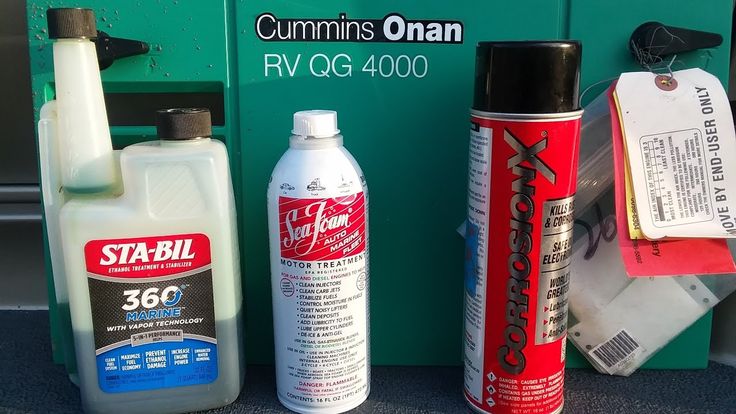 Shut the engine off and allow it to “Hot Soak” for 15 minutes. After the Hot Soak period restart the engine and road test the vehicle aggressively until the exhaust is clean (road test normally takes 5 to 10 miles of driving). Easy to follow directions are also available right on the Sea Foam Spray container.
Shut the engine off and allow it to “Hot Soak” for 15 minutes. After the Hot Soak period restart the engine and road test the vehicle aggressively until the exhaust is clean (road test normally takes 5 to 10 miles of driving). Easy to follow directions are also available right on the Sea Foam Spray container.
Treatments like this may seem complicated, but with a little bit of prep work, you can do it yourself and restore your vehicle’s power and performance. If you have any concerns, stop by your local NAPA Auto Parts Store or NAPA AutoCare Center.
Check out all the chemical products
Categories
Know How
Tags
additive, bad fuel, chemicals, diesel, diesel fuel, engine, fuel, fuel additives, fuel economy, fuel system, fuel system cleaner, fuel tank, oil change, Sea Foam, Seafoam, video
A life-long gearhead, Jefferson Bryant spends more time in the shop than anywhere else.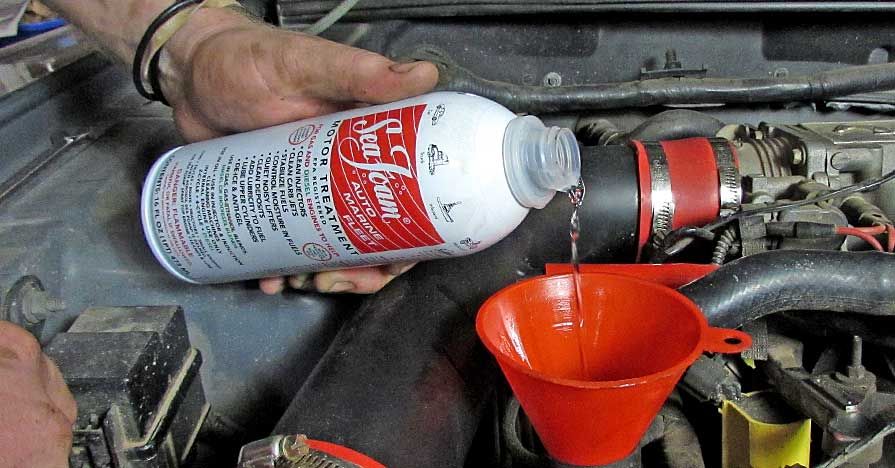 His career began in the car audio industry as a shop manager, eventually working his way into a position at Rockford Fosgate as a product designer. In 2003, he began writing tech articles for magazines, and has been working as an automotive journalist ever since. His work has been featured in Car Craft, Hot Rod, Rod & Custom, Truckin’, Mopar Muscle, and many more. Jefferson has also written 4 books and produced countless videos. Jefferson operates Red Dirt Rodz, his personal garage studio, where all of his magazine articles and tech videos are produced.
His career began in the car audio industry as a shop manager, eventually working his way into a position at Rockford Fosgate as a product designer. In 2003, he began writing tech articles for magazines, and has been working as an automotive journalist ever since. His work has been featured in Car Craft, Hot Rod, Rod & Custom, Truckin’, Mopar Muscle, and many more. Jefferson has also written 4 books and produced countless videos. Jefferson operates Red Dirt Rodz, his personal garage studio, where all of his magazine articles and tech videos are produced.
by Chris Gilliland
SeaFoam is a petroleum-based motor treatment that is used extensively by automotive enthusiasts, but can also be beneficial in maintaining or restoring a motorcycle. SeaFoam is added to your motorcycle's fuel supply, preventing the gasoline from breaking down over time, while cleaning the carburetors and lubricating the engine cylinders. Adding SeaFoam to the engine oil will prevent moisture buildup and remove engine sludge. Additionally, SeaFoam can be used as a soaking agent to clean carbon-coated parts. Very little technical knowledge is needed to apply SeaFoam to your motorcycle.
Additionally, SeaFoam can be used as a soaking agent to clean carbon-coated parts. Very little technical knowledge is needed to apply SeaFoam to your motorcycle.
Open your motorcycle's fuel tank cap, using the ignition key or the cap release lever.
Fill the fuel tank almost completely, using the grade of fuel required by your motorcycle. Refer to your motorcycle's owner's manual if you are uncertain what fuel grade is required.
Add 1 oz. of SeaFoam for every gallon of gas in your motorcycle's fuel tank, then close the fuel tank cap.
Ride your motorcycle as you would normally. Repeat the fuel treatment as desired at every fill-up.
Unscrew the oil filler cap from your motorcycle's oil tank or engine crankcase.
Pour 1 to 1.5 ozs. of SeaFoam into the oil tank or engine crankcase, using a funnel.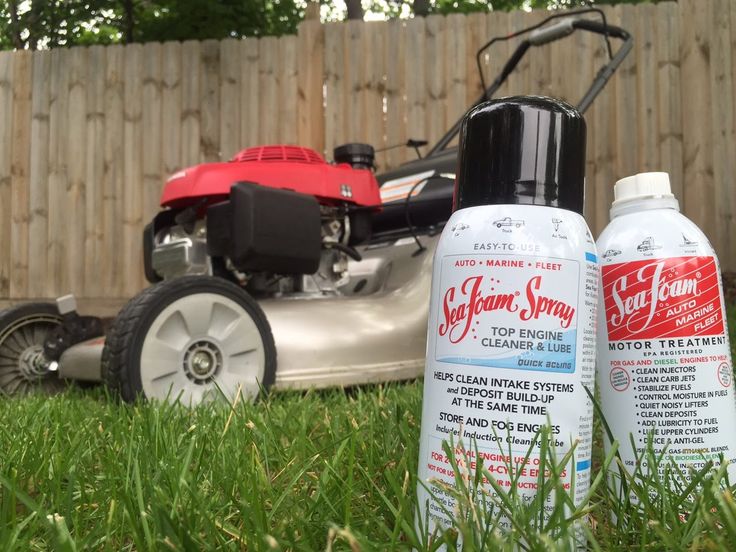 Screw the oil filler cap into place.
Screw the oil filler cap into place.
Ride your motorcycle as you would normally. Check the engine oil every 50 miles, looking specifically at the oil's condition. Change the oil and filter if the oil appears dirty, dark or cloudy. Repeat as desired.
Fill a container large enough to hold your part with SeaFoam.
Clean the part with a shop towel to remove loose debris from the part's surface.
Soak the part in your container filled with SeaFoam for at least 24 hours, then remove the part and wipe dry with a shop towel. If the part is still coated with carbon deposits, soak the part in SeaFoam for another 24 hours.
References
Tips
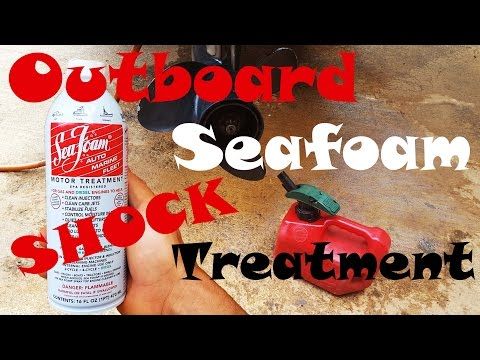
Things You'll Need
Warnings
Writer Bio
An avid motorcyclist, Chris Gilliland has immersed himself into the two-wheeled world while balancing work life and raising three daughters. When he is not managing the parts department of a local, multi-line motorcycle dealership, Gilliland can often be found riding, writing or working on his motorcycle blog, Wingman's Garage.
Photo pravdapfo.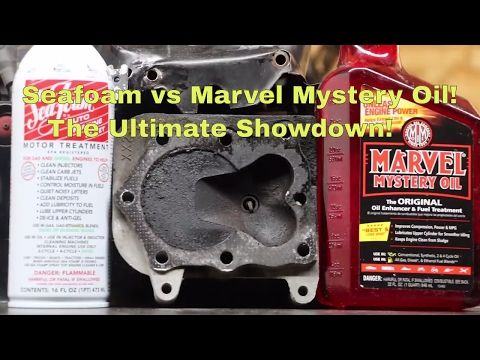 ru for economic reasons - in the ATV crankcase ordinary automobile oil. Well, what, after all, in principle, the all-terrain vehicle engine is not much different from the “fiery heart” of the car. However, experienced quad mechanics know how destructive a purely automotive lubricant is to an ATV motor. nine0009
ru for economic reasons - in the ATV crankcase ordinary automobile oil. Well, what, after all, in principle, the all-terrain vehicle engine is not much different from the “fiery heart” of the car. However, experienced quad mechanics know how destructive a purely automotive lubricant is to an ATV motor. nine0009
Dmitry Zlenko
There is a common belief that all oils are poured from the same barrel, and therefore it does not matter what kind of lubricant to use: cheap automotive or special and expensive for ATV. In reality, oils for car engines are very different from oils for quadrics.
To start with, ATV engines always operate under very difficult conditions. Elevated temperature conditions (due to a radiator clogged with dirt) and prolonged loads lead to the fact that ordinary automotive oil poured into an ATV engine quickly loses viscosity, becoming more liquid, and therefore does not provide the necessary pressure in the system. Which promises a quick death to the motor. nine0009
nine0009
The second feature of the ATV engine is high RPM. For example, for a car, a range of 2500-3500 rpm is considered the average norm. But the ATV is just starting to take off when these thresholds are reached. The average operating mode is in the range of 6000-7500 rpm.
And ordinary car oil is not able to work for a long time in such conditions: it not only loses its lubricating properties, but begins to burn out, leaving carbon deposits on the insides of the engine and forming sludge (thick deposits) that clogs the oil channels of the internal combustion engine. Then there is a chain reaction: piston rings lie down, the engine begins to “eat” oil with terrible force, and ultimately the piston stands up in a dry cylinder with a stake. nine0009
Photo avtovzglyad.ru
Photo avtovzglyad.ru
But that's not all. Most modern ATV engines have a so-called oil-bath clutch (also called a “wet clutch”). Ordinary automotive oil is a killer fluid for clutch friction linings. For the normal operation of the engine with a “wet clutch”, the oil requires a whole range of additives, thanks to which the clutch does not slip and its friction clutches are not destroyed. nine0009
Ordinary automotive oil is a killer fluid for clutch friction linings. For the normal operation of the engine with a “wet clutch”, the oil requires a whole range of additives, thanks to which the clutch does not slip and its friction clutches are not destroyed. nine0009
These additives are only found in motorcycle and ATV engine oils. For example, Liqui Moly ATV 4T Motoroil Offroad 10W-40 synthetic engine oil was specially created for heavily loaded off-road motorcycles. That is, it can be poured both into the engines of side-by-side ATVs (all-terrain vehicles with an automotive layout of controls), and into the engines of cross-country motorcycles, pit bikes and enduros.
This grease is universal, and thanks to a complex of special additives, it is suitable for engines with wet and dry clutches, air and water cooling, and even for engines that have a wet type CVT. The viscosity characteristics of the product ensure stable operation of the lubrication system motor in any season. In addition, Liqui Moly ATV 4T Motoroil Offroad 10W-40 has excellent resistance to high temperatures, water and dust. nine0009
In addition, Liqui Moly ATV 4T Motoroil Offroad 10W-40 has excellent resistance to high temperatures, water and dust. nine0009
At the same time, before buying even a specialized oil for an ATV, be sure to study the equipment manufacturer's recommendations for tolerances for temperature, viscosity and other characteristics. After all, in 70 percent of cases, the engines of the apparatus for "mud-mixing" have one more nuance in the form of a gearbox combined with the crankcase. That is, with such a design, the gearbox is lubricated not with gear oil, but with the same oil as the crank mechanism. nine0009
Photo avtovzglyad.ru
Photo avtovzglyad.ru
In addition, there are no generators in ATV power units. The current for charging the battery and feeding the on-board systems is generated by a magneto, which in most cases is not “dry”, but “wet”, that is, it is located inside the engine and is washed by engine oil from all sides.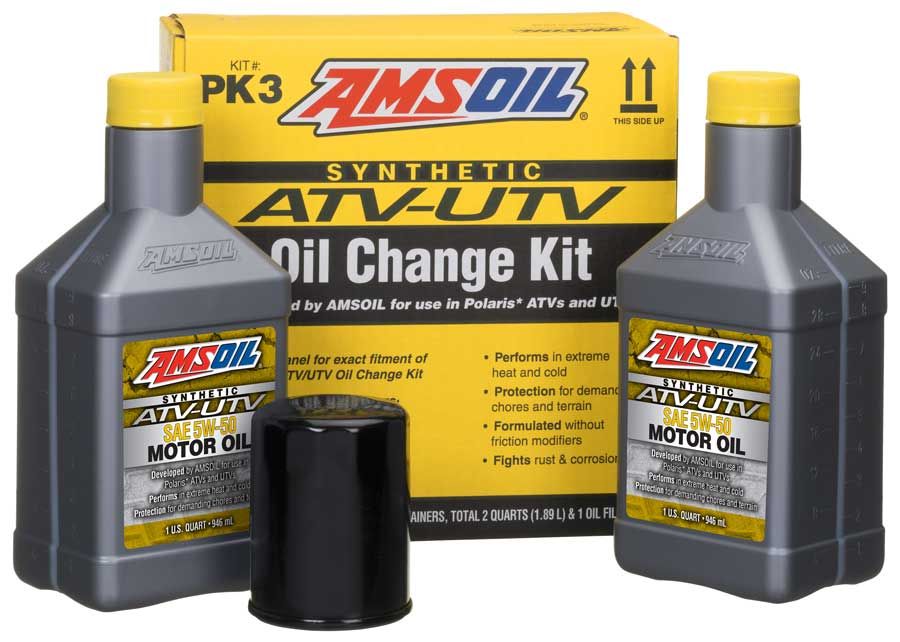 It is no secret that the magneto winding is covered with a thin layer of varnish, which is washed out by interacting with ordinary automotive oil. nine0009
It is no secret that the magneto winding is covered with a thin layer of varnish, which is washed out by interacting with ordinary automotive oil. nine0009
Thus, the operation of the quadric on car oil will inevitably lead to the fact that the magneto closes over time and it stops producing a charge. Replacing this node, depending on the model and brand of the ATV, can easily cost a pretty penny. If you use a special oil for ATVs, then there will be no problems with washing out the varnish from the magneto winding, since such a lubricant contains a special additive that is so necessary to protect the varnish.
By the way, in the German Liqui Moly product line there is a motor lubricant suitable even for exclusive motors for which 10W-40 viscosity oil is not on the manufacturer's recommendations list. For highly forced and turbocharged ATVs, oil with the maximum degree of protection is usually used. Yes, it costs more than the average ATV lubricant, but it guarantees the smooth operation of the most modern engines.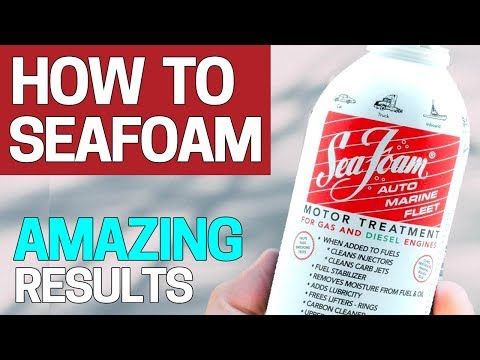 Synthetic engine oil for 4-stroke engines Liqui Moly ATV 4T Motoroil 5W-50 is the "top". nine0009
Synthetic engine oil for 4-stroke engines Liqui Moly ATV 4T Motoroil 5W-50 is the "top". nine0009
Photo avtovzglyad.ru
Photo avtovzglyad.ru
After all, the complex of anti-wear additives and the base base ensure the correct and trouble-free operation of the ATV or UTV engine at the widest possible temperatures, providing maximum protection of the ATV or UTV motor at the widest possible temperatures, any, even extreme, operating conditions.
The use of such a lubricant makes it possible to ensure high reliability of ATV units and ease of starting the engine even at very negative temperatures. It, meanwhile, easily mixes up with all standard oils. Detergent additives keep the engine perfectly clean, cleaning not only the oil channels, but also the walls of the motor. nine0009
It is absolutely contraindicated to pour automobile oil into the motor of an ATV, because this leads to the complete and inevitable death of the power unit of the all-terrain vehicle.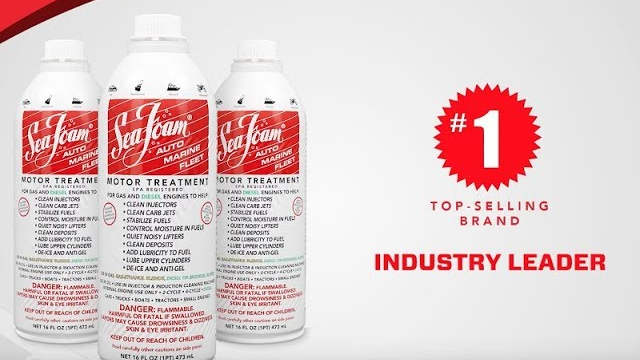 Yes, special oils for ATVs are more expensive than oils for cars, but when the engine of your favorite toy is “poisoned” by a “medicine” that is contraindicated for it and goes to another world, you will understand that the miser always pays twice. Alas, but you will understand too late
Yes, special oils for ATVs are more expensive than oils for cars, but when the engine of your favorite toy is “poisoned” by a “medicine” that is contraindicated for it and goes to another world, you will understand that the miser always pays twice. Alas, but you will understand too late
Smoke - and will go
20841
Submarine - and go
20841
Subscribe to Autovzglygs:
quads, off-road, car service, repair, maintenance, engine oil, car chemicals, life hack
Contents:
When using active types of equipment, do not forget about its maintenance, monitor the general condition of the ATV and change or top up technical fluids in time. The service life of the equipment depends on this.
The service life of the equipment depends on this.
Using only original components and engine oils for ATV , recommended by the manufacturer of equipment, you can fully enjoy the "high" from owning such a machine, because it will not let you down, no matter what difficult situation you find yourself in. nine0009
Do not use regular automotive ATV engine oil. Consider the main reasons.
Characterized by dusty atmosphere, frequent idling and regular off-road driving.
Small crankcase volume, increased oil circulation and high thermal load on the engine due to its high thermal stress. Therefore, in real ATV operating conditions, only a special oil developed in accordance with the requirements of the motorcycle manufacturer, as well as taking into account the real operating conditions of ATVs, can reliably protect the engine. nine0009
nine0009
So, CFMOTO G-Motion 4T 5W-40 and 10W-40 oils were developed by Gazpromneft-Lubricants specifically for CFMOTO ATVs. The CFMOTO G-Motion 4T 5W-40 and 10W-40 range are semi-synthetic ATV engine oils manufactured from synthetic and highly refined mineral base oils.
CFMOTO G-Motion engine oil for all-terrain vehicles.The main advantage of CFMOTO G-Motion 4T 5W-40 for the consumer is the ability to use the product in a wide range of operating temperatures: for example, the oil provides a cold start of the engine down to -30 0 C.
In turn, CFMOTO G-Motion 4T 10W-40 provides increased engine protection at very high loads by maintaining a stable oil film.
There are other features of these particular oils, showing that they have high performance characteristics, which have been repeatedly confirmed by oil tests in real conditions (see Presentation of test results).
Choosing ATV Engine Oil , by the way, do not forget about other ATV parts that need lubrication.
For example, gearboxes and transfer cases require gear oil, which also “wears out” and needs to be changed regularly. It is necessary to check the oil every MOT (TOs are carried out according to the regulations described in the Service Book, which can be downloaded on the page of each ATV (see download files, for example, CFMOTO X8 Basic Restyle). As a rule, change the oil in the 1st MOT (the first 500 km ), and after - through maintenance, that is, 3000 km, 6000 km, etc.
CFMOTO recommends Gazpromneft GL-4 80W-90 gear oil.
ATV Gear OilIt is also necessary to regularly update the grease (suspension elements, cardan joints, etc.), which, over time, picks up dirt and is washed out with water. Therefore, we recommend using a waterproof multi-purpose grease based on the lithium-complex thickener Gazpromneft Grease LX EP 2.
multi-purpose lubricant Gazpromneft Grease LX EP 2. Brake fluid gradually takes water out of the air over time and begins to boil at lower and lower temperatures, which is not the best effect on your safety.
For CFMOTO ATVs of our own line, we recommend using the time-tested brake fluid G-Energy Expert DOT 4 , boiling point. As a rule, liquids of different classes are reversely replaceable (except for silicone brake fluids - they cannot be mixed with others), that is, you can use DOT-4 instead of DOT-3, but in no case vice versa. CFMOTO recommends using more state-of-the-art DOT-4 brake fluid to improve safety and extend the life of the brake system). nine0009
As you can see, antifreezes differ in color, but it is important to remember that the color of the antifreeze does not affect the technical characteristics. At the same time, it should be borne in mind that the “acidic” color of antifreeze only indicates that the composition contains a fluorescent additive that plays an important role in the diagnosis of the cooling system - coolant leaks are established (glow) when the engine compartment is illuminated with ultraviolet light. nine0009
Expert tip:
Therefore, the choice of antifreeze should not be guided by the rule "color to color".